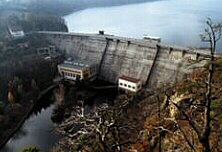 |
| Vranov Dam at the Czech-Austrian border is an example of man-made facilities that modify the character of rivers |
Besides about 850 major dams and reservoirs recorded in the "Thematic
Maps of the Danube River Basin” (Danube Pollution Reduction Programme
1999, available at www.icpdr.org) there are some 450 small dams and weirs
across the Danube Basin. Since many of them are already quite old, they
will soon need to be re-licenced. Their operation will be reviewed against
the principles of modern river management as defined by the EU Water Framework
Directive and amid a growing public interest in river restoration.
The debate about the benefits and drawbacks of dams has been going on for
decades. While thousands of dams built after World War II were seen as symbols
of technological progress and economic welfare, the build-up of knowledge
about human intervention into natural processes has caused such views to
be seriously questioned. Apart from the fact that most hydraulically attractive
sites for dam building had already been used up by 1970, a number of new
dam projects have since then been stopped, postponed or completely scrapped
in response to public opposition or environmental interests. Dam-related
conflicts such as those at Hainburg/Austria in 1984 or at Gabcikovo-Nagymaros
in 1988-97 also seem to belong to history.
Systematic revisions of water and river management laws have been carried
out over the past 15 years, spurred by the need to reconcile economic and
ecological objectives in the management of water and to preserve and restore
the river's ecological functioning (e.g. Austrian Waterworks Law, 1994).
The EU Water Framework Directive goes even a step further by demanding that
all bodies of surface water should achieve "good ecological and chemical
status” by 2015. The practical implementation of this standard is currently
being discussed by a number of EU working groups, with a tendency to limit
exceptions (see box).
 |
| New dam operation has to provide for more ecological water management in the transboundary national park along the Dyje/Thaya river |
The practical challenge that these new framework conditions set for river
and dam managers is reflected in the present negotiations for a new license
for the Vranov Dam on the Dyje/Thaya River that forms the border between
Austria and the Czech Republic. The 39-kilometer-long and up-to-58-meter-deep
Vranov Reservoir was built in this meandering river canyon in 1934 and serves
peak power production and water supply needs. Apart from the fact that this
deep reservoir disrupts the natural river continuum, its changed water quality
(reduced sediments, temperature, nutrients, oxygen, etc.) and the fluctuating
discharge (increasing twice a day from 1 m3/sec to 30-40 m3/sec) pose serious
problems for the downstream water ecosystem. As a result, the character
of the river and its species composition (fish, zoobenthos, etc.) have been
undermined and are less stable than they would be under natural conditions.
In 1991, the Czech national park, Podyji, was established along the river
and its forested slopes. Its regulation requires that water management in
the core zone should prevent disturbances of the river ecosystem and that
the operation of the Vranov Dam should secure an ecologically sound discharge
regime (Art.11). Based on a scientific study of the Masaryk University (Helesic
and Kubicek, 1999), Podyji National Park now demands that the minimum discharge
should be increased to 2.4 m3/sec for the ecologically sensitive period
from November to August. This standpoint is supported - as a first step
towards a comprehensive water management concept - by the Lower Austrian
water management authorities and by the Austrian sister national park, Thayatal,
on the southern banks of the river. The upcoming decision of the Czech authorities
(district South Moravia) will send a signal to decision makers about other
dams in the Danube Basin.
|
Ecological classification according to WFD
For surface waters the overall aim of the WFD is that EU member states should achieve "good ecological and chemical status” in all bodies of surface water by 2015. The ecological classification is type-specific. For each river, lake, transitional and coastal water, the relevant surface water body needs to be differentiated according to its physical and chemical characteristics. The ecological status is determined by assessing the status of its biological quality elements that include aquatic flora, benthic invertebrate fauna and fish fauna. These are supported by hydromorphological elements, chemical and physico-chemical elements. The good status is defined in general terms in Annex V, 1.2 WFD as values deviating only slightly from those normally associated with the surface water body type under undisturbed conditions. For each water body type, the good status needs to be defined more precisely on the basis of quality elements. |